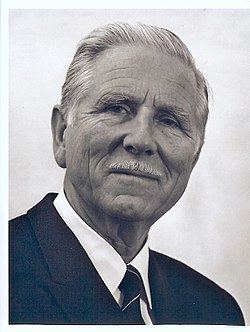Name Johan Richter | Role Inventor | |
 | ||
Johan richter paper industry international hall of fame
Johan Richter (Johan Christopher Fredrik Carl Richter, 12 November 1901 – 13 June 1997 in Oslo) was an engineer, industrialist and inventor in the area of pulp and paper production. Kamyr in Karlstad Sweden (which split in two in 1989 and now is part of Andritz AG and Metso Paper) was created on the basis of his inventions.
Contents
- Johan richter paper industry international hall of fame
- Background
- Inventor and executive
- Post CEO activity
- Honours and awards
- Trivia
- References
Background
Richter was born in Lier, Buskerud and grew up at Narvik in Nordland, Norway. His father had a management position at LKAB who shipped its ore through Narvik. From 1919 he went to school in Trondheim commuting on the Hurtigruten as there was no roads at that time. He graduated as a Mechanical Engineer Norwegian University of Science and Technology in 1924. After a short venue in Narvik he took on a position in France where is worked on turbines and advanced pumping equipment. In France he met and married Astri Rören (1908–1992). Two children: Ole Johan (1929) Einar Christian (1932–1997). Richter returned to Norway and settled in Oslo where he joined Thunes Mechanical workshop. He continued to work on turbines but there were as well some new ideas within pulp bleaching. However, due to the Great Depression he was let go in 1932.
An industrialist, Knud Dahl, at Myrens Verkstäder (Myrens Mechanical Workshop) had heard about Richter and they met. Richter convinced Dahl he had the vision and skills to develop a new technology for pulp bleaching in a continuous process. Myrens Verkstäder and Karlstads Mekaniska Verkstad (KMW) in Sweden already had a small joint venture within pulp and paper technology named Kamyr that was located in Karlstad, Sweden. Dahl hired Richer to head up the organisation with the specific task to develop and market new technologies for bleaching and other innovations within pulp and paper. Richter then moved with his family to Karlstad.
Inventor and executive
In the middle on the 1930s, Kamyr launched their new process for continuous bleaching that was developed and patented by Richter. The company had an immediate success initially in Europe and later worldwide. Kamyr grew quickly and obtained the necessary resources and creditability for innovations to come. Richter already had a vision to introduce a process for continuous cooking of pulp. So far this had been done in batches, with its drawback in quality variance and being a barrier to rational nonstop production of paper. So far nobody had even tried to conquer this area and it proved to be way more complicated than with bleaching. It took more than 10 years from the first pilot in 1940 to a fully operational unit. Richter always insisted on full scale testing. The first installation was able to produce 30 tons per day. A Richter digester of today will produce more than 2500 tons per day.
He became the CEO of Kamyr in 1950 while still being directly responsible for Research and Development. In the following years Kamyr obtains more or less a monopoly position as no other supplier was capable of presenting something similar. Paper mills all over the world switched to continuous uninterrupted production of pulp and paper which created considerable savings and a stable quality of the end-product.
Post CEO activity
In 1959, Richter decided to step down as CEO of the company in order to re-focus on the technology. He assumed the title Chief Technical Advisor to the Kamyr Group (now based both in Sweden and the US). He stayed in that role until 1993 (being above 90 years old). One of Richter’s strengths was that he did not regard innovation as a one-off event, but rather a process of improvements. Hence he was able to reach more than 750 patents awarded worldwide. During this period Richter had relocated to France and collaborated with his son, Ole Johan, who was the one “on the location”, building and testing equipment and eventually also adding to the patented solutions.
Honours and awards
Trivia
Johan's granddaughter Agneta Dahlfors-Richter is Professor of Microbiology at the Karolinska Institutet in Stockholm, where she founded the Swedish Medical Nanoscience Center. She is independently and within teams behind several innovations which have received patents (or under application). Among others an artificial nervecell.
